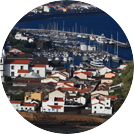Faial

Located only 4.5 nautical miles from the island of Pico and approximately 14 nautical miles from the island of São Jorge, Faial is one of the ‘Triangle Islands’. Recognised as a the yachting capital of the northern hemisphere, it has a strong connection to the sea with its main port – Horta Marina – providing a safe harbour for thousands of vessels as they cross the Atlantic. The number of sailboats huddled in the small bay adds to the charm of this city, which lies in the shadow of the extinct volcano of Guia Hill. No visit to Horta is complete without a visit to one of its most famous Portuguese bars - Peter’s Café Sport. Overlooking the Marina with Mount Pico as its backdrop, the walls are covered in flags left by travellers, giving the bar a sense of the history of the city.
Faial was the site of the Azores last major eruption, the Capelinhos Volcano (1957/58). The landscape created by the eruption on the island’s west tip makes for a fascinating day trip and the Capelinhos Volcano Interpretation Centre has lots of information about the devastation caused by the event.
For divers, the main reason for a trip to Faial Island is the opportunity to dive with blue sharks. This is one of the only places in the world that you can swim with this amazing predator and although it is possible to do it on several of the Azores islands, the best place is the Condor seamount which is just ten miles offshore and accessible from Faial.
Because Faial and Pico are so close together, divers can experience the benefits of both islands. On Faial you have the some fantastic opportunities to dive around Guia Hill and in the Faial-Pico channel, as well as the Espalamaca Fumaroles where you can observe active volcanic springs of hot water and curtains of small bubbles emerging from the seabed. On Pico there is excellent rocky coastline to explore. Faial is also one of the main departure points for trips to the Princess Alice Bank, located about 45 nautical miles away and one of the best dive sites available in the Azores because of the large schools of pelagic fish, manta rays and sharks.


